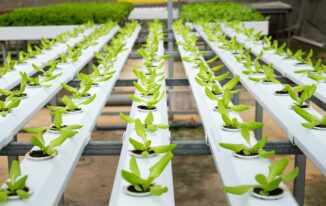Whether people want to cultivate a few indoor plants in a hobby grow room or they want to set up large-scale commercial indoor farms, the choice of lighting is one of the biggest decisions they’ll have to make. Understanding options when it comes to growing lights is tough given how fast the technology is progressing. This article will offer a brief guide to comparing grow lights so that everyone from hobby growers to aspiring commercial indoor farmers can make informed decisions.

What Are Grow Lights?
Before discussing the different lighting options out there, let’s make sure everyone is on the same page. There are many different grow lights, but what they all have in common is that they provide an optimal spectrum of radiation for growing plants. These artificial lighting sources can supplement natural light, as in a greenhouse, or they can provide 100% of the light required to facilitate photosynthesis.
Why Plants Won’t Thrive Under Household Lighting
Household lamps and fixtures are designed with a different purpose in mind. They ensure that everyone can see at night, but they don’t necessarily produce the wavelengths of light required for plants to grow and thrive. Incandescent bulbs, in particular, are terrible for growing plants. They produce a lot of red spectrum light, but virtually no blue-spectrum light. Incandescent also tend to run hot, which can burn the plants.
HID Bulbs
HID, short for high-intensity discharge, lights are large bulbs that contain gas. When the gas is ignited, the bulb produces light. There are two types of HID bulbs: high-pressure sodium (HPS) bulbs favor red-spectrum light, while metal halide (MH) lights produce more light on the blue end of the spectrum.
There’s at least one important reason to pay attention to the distinction between red and blue spectrum light. Most plants need more light in the blue spectrum during their vegetative stages since it supports chlorophyll production. When they flower or fruit, they need more red light. Most growers who use HID bulbs transition over from MH to HPS grow lights when their plants begin to flower.
Pros of HIDs
HID lights are good at providing adequate light intensity, which can lead to good yields if growers switch over from MH to HPS bulbs at the right point in the season. It’s relatively easy to switch from MH to HPS lights, too, since both can be held in the same digital ballasts.
Cons of HIDs
HID bulbs tend to burn hot, which means they must be placed an adequate distance away from the plant canopy. They also require expensive hardware such as ballasts and reflectors, some of which will only work with MH or HPS lights. HPS bulbs also lose their efficiency over time, so they need to be changed out frequently.
Specialized HID Grow Lights
More specialized forms of HID grow lights such as ceramic metal halide (CMH) and light-emitting ceramic (LEC) bulbs operate similarly to MH bulbs. However, they feature added insulation to prevent excess heat transfer and produce a full spectrum of light required to facilitate growth, which means there’s no need to switch out bulbs. The bulbs also last up to twice as long as traditional MH and HPS alternatives.
While CMH and LEC bulbs can be a good solution for some growers, it’s worth noting that they also produce more UV light. That’s great for plant production but can hurt human growers. Take precautions during installation and use to prevent burns when choosing these types of lights.
Fluorescent Grow Lights
Fluorescent lights are almost ubiquitous as office fixtures, but not everyone realizes that they sometimes double as grow lights. Growers sometimes purchase T5 fluorescent bulbs with high output ratings and adjusted ballasts to produce brighter light.
Pros of T5 Fluorescent Lights
T5 fluorescent grow lights have one primary advantage over HIDs: they’re less expensive. Fluorescent lights are also good for the propagation stage of indoor grows. Beyond that, there aren’t many advantages to opting for fluorescent lighting.
Cons of T5 Fluorescent Lights
Fluorescent lights suffer from the same problem as traditional HIDs. Each one has a limited light spectrum, which means growers will need to change out the bulbs halfway through their seasons. Also, like HIDs, fluorescent grow lights require the use of a specialized ballast, which can complicate the initial installation.
LED Grow Lights
Light-emitting diode (LED) grow lights are becoming more popular every year. They operate a little differently from traditional light bulbs. They don’t rely on filaments or gas. Instead, they provide illumination by moving electrons through a semiconductor material.
Pros of LED Grow Lights
LED grow lights are more efficient than HIDs or fluorescent lights. As a result, they also generate less heat, which means they can be placed closer to the plant canopy. Don’t underestimate the difference that makes in the long run. Not only do LED grow lights cut back on operating costs by reducing energy expenditure to about half of that associated with HIDs, but they also reduce the need for supplemental cooling systems in the summer and allow growers to make better use of their space.
The best part is, LED lights are easy to install, easy to use, and longer-lasting than other lights. There’s no need for a ballast or a reflector hood, and high-quality lights provide a full spectrum of radiation that accommodates plants’ needs throughout their entire growing cycles. Many growers report higher quality and better yields after switching to LEDs.
Cons of LED Grow Lights
The only real problem with LED lights is that they can be prohibitively expensive. Energy rebates may be available to help offset the initial investment, and even when that’s not the case, growers can expect to make their money back over time as they reap the benefits of increased efficiency and reduced heat production.
The Bottom Line
There’s no one solution that’s right for every situation. Large-scale indoor farmers often opt for specialized HID grow lights to cut down on costs. Hobbyists just getting started may want to try fluorescents, though they usually switch to a more efficient lighting source after just one season. For those who can afford a higher initial investment, LEDs are almost always the way to go. No matter what type of light buyers choose, they should purchase the bulbs and equipment from a reputable grow light supplier that can answer questions and provide ongoing support.



